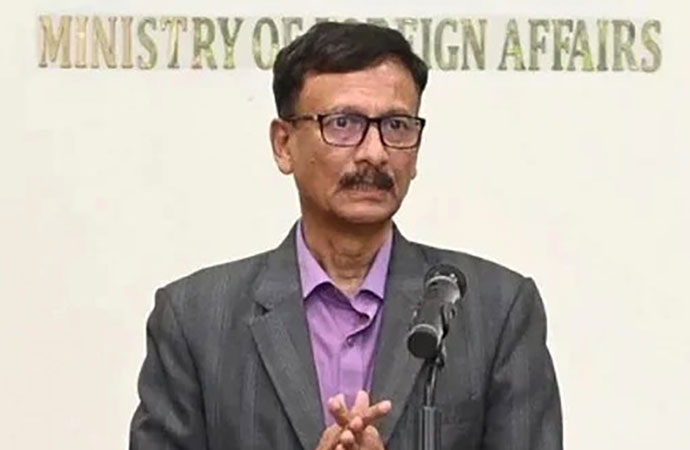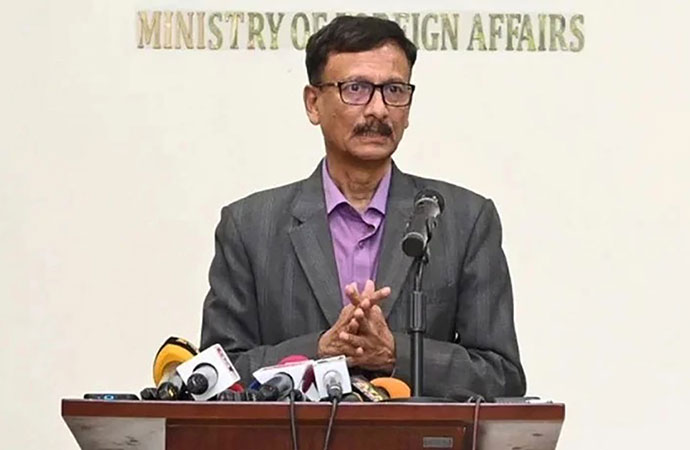Society

Three female sub-lead farmers learning how to implement Climate Smart Agriculture (CSA) from a lead farmer under USAID's Nobo Jatra Project in Kaliganj Upazila in Satkhira. Photo: Courtesy
The largest deltaic land of Bangladesh is mostly known to the world as one of the most disaster-prone countries where people fight several natural calamities every year. Amid the climate change-related impacts, Bangladeshi farmers continue contributing to the national economy. According to Bangladesh Economic Review 2023, the agriculture sector's share in Gross Domestic Product (GDP) at constant prices stood at 11.20 percent in FY 2022-23.
After struggling all year round with multiple disasters, Bangladeshi farmers live and help us survive with the necessary foods to eat. They use their techniques learned directly from the fields. Climate Smart Agriculture (CSA) is an approach to farming that aims to address the challenges posed by climate change while promoting sustainable agricultural practices. The concept of CSA emerged as a response to the need for agriculture to adapt to changing climatic conditions and contribute to mitigating greenhouse gas emissions.
Bangladeshi Farmers' Techniques
I saw my father cultivating vegetables on a floating raft of dense water hyacinths during my childhood in the 1990s. My village in Gopalganj district is situated in a marshland area, where the arable land stays underwater for half of the year. Interestingly, the knowledge of cultivating crops on the floating raft was solely a locally managed adaptation mechanism to climate change-related impacts. Thus, the farmers in other regions also practice the same mechanism.
Bangladesh's southern part, where salinity is one of the most talked about issues for farmers who face multiple natural calamities all year round. Floods, tidal surges, cyclones, and erosion are very common here. During my first visit to salinity-prone Dacope Upazila in Khulna, I met an innovative farmer named Jagadish Haoli in May 2023. Jagadish invented his mechanism to fight salinity in agriculture. He started using tamarind shells to reduce the extent of saline water around the tree roots. He said that his technique worked very well. I was astonished to listen to his own adaptation mechanism.
Sharing his own practical experiences in agriculture, Jagadish said, "Water is the main crisis for crop cultivation in the coastal region, but proper knowledge and application of Climate Smart Technology (CSA) promptly can be a successful mitigation strategy."
Farmers like Jagadish in the southwest region of Bangladesh have started applying Climate Smart Agriculture (CSA) for the last few years with assistance from the Department of Agricultural Extension (DAE), NGOs, and I-NGOs.
CSA Practices, Profitability for USAID's Project
A survey titled Participant Annual Sample Survey (PASS) by World Vision Bangladesh under USAID's Nobo Jatra Project II (NJP II), reveals that 6,278 value chain farmers (f-6,081; m-197) earned over USD US $27,99,353 by producing four specific crops and ducks in four Upazilas under Satkhira and Khulna district from October 2022 to September 2023.
The producers from Koyra and Dacope Upazilas in Khulna district and Shyamnagar and Kaliganj Upazilas in Satkhira earned the revenue by producing bottle gourd, bitter gourd, watermelon, Genetically Improved Fish Tilapia (GIFT), and ducks. (USD 1 = BDT 94.18 is calculated). The value chain farmers produced 327.84 MTs of bitter gourd, 1,122.35 MTs of bottle gourd, 249.88 MTs of GIFT, 15,069.19 MTs of watermelon, and 452,749 pieces of ducks and eggs in one year.
USAID's NJP II, implemented by WVB has been promoting CSA practices in Bangladesh's southwest region. Currently, over 11,048 agriculture-smallholder producers, 6,278 value chain farmers, 199 lead farmers, and 899 sub-lead farmers, are using improved management practices or CSA technologies in Satkhira and Khulna districts.
Traditional Cultivation and CSA
For decades, Bangladeshi farmers have been inventing their own coping mechanisms to fight climate change-related impacts on agriculture. However, the traditional coping mechanism takes extra time to experience. In that case, the knowledge from the laboratory can contribute to reducing farmers' experiments on the ground.
The NJP II's farmers have been applying climate-resilient and short-duration crop varieties, organic fertilizers, mulching, intercropping, dike cropping, early and delayed planting, drip irrigation, liming, integrated pest management, vertical gardening, improved and climate resilience Khaki Campbell breed, proper house management, feeding, schedule vaccination, proper disposal, and bio-security maintenance.
Recently, private companies have started introducing saline-tolerant seed varieties. Joyanti Ghorami, a woman farmer from Dacope Upazila used to apply traditional ways in crop cultivation before 2016, but now my husband and I follow the CSA techniques. Now, she saves over USD 3,240 every year after meeting all production costs and family expenses.
NJP II's Chief of Party Lima Hanna Daring said that the farmers in the coastal areas are more resilient and well-connected with private sectors, government departments, various input-output sellers, and buyers. Their profitability has increased through adapting CSA technologies.
Roton Malo is a freelance journalist and development worker. Currently, he is working for USAID's Nobo Jatra Project II (NJP II) implemented by World Vision Bangladesh. Email: rotonmalo@gmail.com

























Leave a Comment
Recent Posts
Remembering Kalidas Karmakar ( ...
The art world remembers Kalidas Karmakar, a visionary whose creativity ...
An Evening with Shishir Bhatta ...
Cosmos Art Echo, the artist talk initiative of Gallery Cosmos and Cosm ...
Myanmar denies genocide, calls Rohingya crackdown co ..
Yes, of course
Earth’s average temperature last year hovered among ..
Bangladesh and Singapore: A Tale of Two Nations